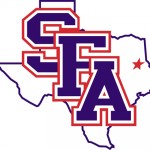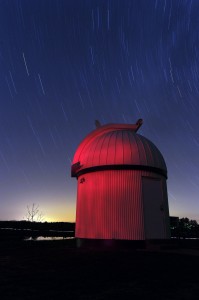
With the addition of a new, remotely operated telescope, the SFA Observatory is continuing to provide astronomy students access to stellar technology and out-of-this-world research opportunities.

STELLAR MOVEMENT – This recent time-lapse photo shows a 20-minute path of stars visible at the SFA Observatory. Photo by Stephanie Ballard, SFA photojournalism student
The second largest in the Central time zone, the SFA Observatory is located 11 miles north of Nacogdoches and employs a number of telescopes that vary in size and strength. The new addition is 16 inches in diameter and eventually will have the capability to be operated from the main campus or other research locations.
“Both undergraduate and graduate students also have the opportunity to gain experience in robotics and computer programming through the use of the new technology,” said Dr. Dan Bruton, astronomer and professor in the SFA Department of Physics and Astronomy. “I want to provide our advanced undergraduates and seniors with state-of-the-art equipment that will allow them to do graduate- and senior-level projects.”
The new remotely operated telescope will be used primarily for asteroid hunting, observing variable stars and imaging deep sky objects such as nebulae, star clusters, galaxies and supernovae. The observatory’s 41-inch telescope is used for star research, and an 18-inch telescope is used to search for minor planets. (11 asteroids have been discovered at the SFA Observatory.) Additionally, a 10-inch telescope is used mostly for training.
The student observatory, the largest teaching observatory in the state of Texas, provides approximately 825 introductory astronomy students each year with the opportunity to view and learn about the wonders of the sky. A dozen portable 8-inch telescopes and four 6-inch Newtonian reflectors can be mounted on pedestals for student use.
The research observatory is used by students and faculty members to broaden our understanding of the universe. It is one of the only facilities of its size in the world that permits regular use by advanced undergraduate and graduate students.
The SFA Observatory also offers free public viewing opportunities, one each spring, summer and fall. Hosted by the SFA chapter of the Society of Physics Students, the public viewing sessions are listed on the observatory website.
“Since many SFA students come from the Houston or Dallas-Fort Worth areas, the views offered through these telescopes in the relatively dark skies of East Texas offer an enjoyable and often unforgettable experience,” said Dr. Norm Markworth, observatory director.
SFA graduates who have taken advantage of the research facilities available at the observatory are prospering in their field, Bruton said. Among them is Justin Parish ’10, assistant director at The Center for Earth and Space Science Education at Tyler Junior College, who attributes much of his success to time spent at the SFA Observatory as a student researcher.
“My experience and knowledge base was made stronger through this plethora of research, which ultimately led to my success in obtaining an assistant director position at a brand new planetarium,” said Parish.
For more information about the SFA Observatory and upcoming public viewing sessions, visit www.observatory.sfasu.edu.



